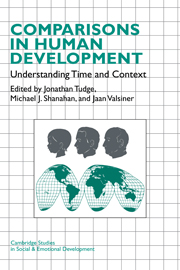Book contents
- Frontmatter
- Contents
- List of Contributors
- Comparisons in Human Development: To Begin a Conversation
- Part One Metatheoretical Approaches to Developmental Comparisons
- Part Two Paradigmatic Statements
- Part Three Comparisons at the Level of Data
- Part Four Commentaries
- 10 Developmental Science: A Case of the Bird Flapping Its Wings or the Wings Flapping the Bird?
- 11 Conceptual Transposition, Parallelism, and Interdisciplinary Communication
- 12 The “Ecological” Approach: When Labels Suggest Similarities beyond Shared Basic Concepts in Psychology
- 13 Problems of Comparison: Methodology, the Art of Storytelling, and Implicit Models
- 14 The Promise of Comparative, Longitudinal Research for Studies of Productive-Reproductive Processes in Children's Lives
- 15 Integrating Psychology into Social Science
- Author Index
- Subject Index
13 - Problems of Comparison: Methodology, the Art of Storytelling, and Implicit Models
Published online by Cambridge University Press: 04 May 2010
- Frontmatter
- Contents
- List of Contributors
- Comparisons in Human Development: To Begin a Conversation
- Part One Metatheoretical Approaches to Developmental Comparisons
- Part Two Paradigmatic Statements
- Part Three Comparisons at the Level of Data
- Part Four Commentaries
- 10 Developmental Science: A Case of the Bird Flapping Its Wings or the Wings Flapping the Bird?
- 11 Conceptual Transposition, Parallelism, and Interdisciplinary Communication
- 12 The “Ecological” Approach: When Labels Suggest Similarities beyond Shared Basic Concepts in Psychology
- 13 Problems of Comparison: Methodology, the Art of Storytelling, and Implicit Models
- 14 The Promise of Comparative, Longitudinal Research for Studies of Productive-Reproductive Processes in Children's Lives
- 15 Integrating Psychology into Social Science
- Author Index
- Subject Index
Summary
The three chapters covered by this commentary deal with social and cultural change (either historical or by way of immigration) and individual adaptation. However, the chapters by Beth Kurtz–Costes and her colleagues (Chapter 6) and by Michael Shanahan and Glen Elder (Chapter 4) deal mainly with the methodology of comparisons, while the chapter by Dorothy Holland and Debra Skinner (Chapter 7) deals more directly with the interaction of the individual and changing, lived worlds. I shall begin with the methodology of comparisons and then move to the experiences of individuals in changing worlds. Finally I will discuss comparisons as storytelling.
The Methodology of Comparisons
Chapter 6
Kurtz–Costes, McCall, and Schneider begin their chapter by outlining five methodological and conceptual issues involved in cultural comparison. I can agree with all of their points if I accept their methodological framework. In my view, the authors' framework is based on a traditional research design that compares specific outcome variables that are to be explained by a small set of variables represented by two or more cultures. This position is apparent when the authors write about “confounding” variables. They seem not to be directly interested in the covariation pattern or configuration of cultural variables. Instead, their approach involves identifying each separate cultural variable as accurately as possible.
- Type
- Chapter
- Information
- Comparisons in Human DevelopmentUnderstanding Time and Context, pp. 318 - 333Publisher: Cambridge University PressPrint publication year: 1996



